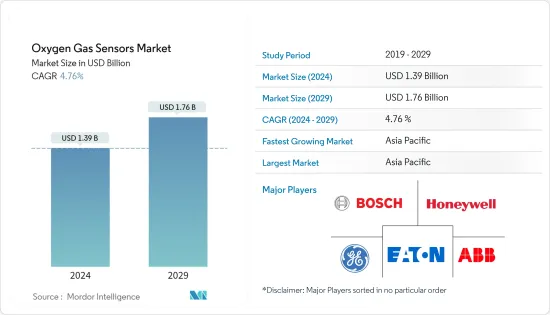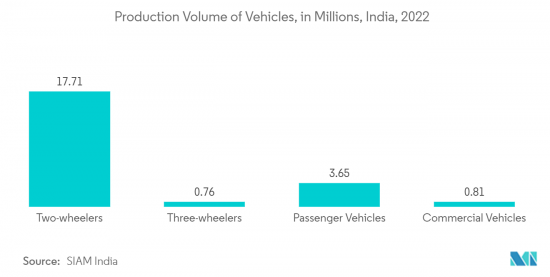PUBLISHER: Mordor Intelligence | PRODUCT CODE: 1403951

PUBLISHER: Mordor Intelligence | PRODUCT CODE: 1403951
Oxygen Gas Sensors - Market Share Analysis, Industry Trends & Statistics, Growth Forecasts 2024 - 2029

The Oxygen Gas Sensors Market size is estimated at USD 1.39 billion in 2024, and is expected to reach USD 1.76 billion by 2029, growing at a CAGR of 4.76% during the forecast period (2024-2029).
Key Highlights
- The ability to reliably measure oxygen concentration or partial pressure and warn about abnormal conditions is critical in industrial safety environments, such as mines, oil production facilities, and chemical plants. This helps in driving the growth of the market.
- The growth in the market can be attributed to the rising demand for oxygen gas sensors in a range of applications, including medical, automotive, and industrial sectors. Also, the increasing number of applications for oxygen sensors, coupled with rapid technological advancements in sensing technologies. Furthermore, the increasing awareness regarding safety and security is also driving the growth of this market.
- Moreover, environmental concerns play a crucial role in driving the growth of oxygen gas sensors. It is known that dissolved oxygen is a critical requirement for the maintenance of balanced populations of shellfish, fish, and other aquatic organisms in both estuarine and nearshore coastal waters. Various projects have been and are expected to be implemented to measure the dissolved oxygen in the water. Furthermore, ammonia, ozone, and chlorine are all toxic gases used in the decontamination stage of wastewater treatment and water purification plants. Such factors will boost the demand for oxygen gas sensors.
- Furthermore, applications ranging from adjusting the air-fuel ratio in automobiles to controlling industrial processes increasingly demand oxygen sensors, as ascertaining oxygen levels accurately is essential. For instance, in August 2022, Premier Auto Trade announced a significant expansion to its Oxygen and Air Fuel Ratio Sensors range. The PAT range now includes over 800 Direct Fit Oxygen Sensors for petrol, LPG, and diesel vehicles with a spread across Japanese, Korean, USA, and European manufacturers. This covers over 14 million vehicle applications in Australia and New Zealand, making it the most extensive range in the Australian Aftermarket.
- For instance, in August 2022, a Maharashtra Startup Got INR 32.9 million (USD 0.40 million) support from the Government for Indigenous Development of Hydrogen Gas Detecting Technology. Multi Nano Sense Technologies signed a memorandum of understanding (MoU) Technology Development Board under DST for the indigenous development of hydrogen sensing and analysis technology.
- Also, the medical application of these oxygen gas sensors is expected to experience rapid growth due to a rising need for precise devices that can measure low levels of oxygen in hospitals and other healthcare facilities. These devices are utilized for monitoring patients who have hypoxic or anoxic injuries, as well as those experiencing cardiopulmonary arrest. Additionally, they are also employed in non-invasive ventilation procedures for patients with respiratory disorders like asthma or chronic obstructive pulmonary disease (COPD).
- Companies are rolling out new products lately to remain competitive in the market. Further, Crowcon Detection Instruments Ltd launched a long-life oxygen sensor in its Gasman portable gas detector. The new sensor has an extended lifespan, which reduces the total cost of ownership and is also completely free of lead, helping organizations to comply with imminent changes to the restriction of hazardous substances (RoHS) regulations and reducing harm to the environment.
- The COVID-19 pandemic pushed healthcare to the limit, but oxygen management in hospitals became a challenge for healthcare systems globally. The safety of healthcare providers and their patients was paramount within the healthcare environment. Moreover, the pandemic resulted in constrained growth in sectors such as automotive, oil and gas, and chemicals, as well as the manufacturing of ventilators, respirators, and other medical devices/equipment necessary for the critical care of patients.
Oxygen Gas Sensors Market Trends
Automotive Sector to Occupy a Significant Market Demand
- Oxygen gas sensors are majorly employed in automobile exhausts to measure the amount of oxygen entering the car cylinders accurately. This instrument is used to manage the released emissions of petrol, diesel, and gas engines. The growing fleet of automotive vehicles, combined with tight government emission control regulations, is expected to stimulate automotive oxygen gas sensor sales in the future.
- Furthermore, the growing retrofitting of automotive oxygen gas sensors for vintage vehicles is expected to provide considerable opportunities for stakeholders in the coming years. In August 2022, the Indian government launched India's first double-decker electric bus in Mumbai. It is working to create an integrated electric vehicle (EV) mobility ecosystem with a low carbon footprint and high passenger density, emphasizing urban transportation reform.
- Rapid advancements in coating materials for automotive oxygen gas sensors are expected to usher in new paradigms in the worldwide automotive oxygen sensor market. Most players now use high-temperature co-fired ceramic (HTCC) green tapes with oxygen sensors to create high-strength and long-lasting vehicle sensors.
- Furthermore, in August 2022, Bosch announced a more than USD 200 million investment to produce fuel cell stacks in Anderson, S.C. A fuel cell operates by using hydrogen to generate electrical energy. As the hydrogen ions pass over the fuel cell plates, they combine with oxygen to create electricity. The only by-product is water, allowing the vehicle to run with zero local carbon emissions.
- Moreover, the industry is governed by strict policies and regulations employed by both national and international authorities, making it mandatory to utilize these systems. The industry depends on oxygen sensors to meet the emission standards governments and concerned authorities set. For instance, most gasoline-powered vehicles are equipped with catalytic converters to comply with the US Environmental Protection Agency's stricter regulation of exhaust emissions.

Asia-Pacific to Mark the Fastest Growth Rate
- The automotive sector in this region is expected to be the significant driver for incorporating oxygen sensors due to the increasing automobile production. According to the India Brand Equity Foundation (IBEF), the Indian passenger car market is predicted to reach a value of USD 54.84 billion by 2027. Indian automotive industry is targeting to increase the export of vehicles by five times during 2016-2026. Furthermore, in FY 2022, total automobile exports from India stood at 5,617,246.
- In addition, in March 2022, MG Motors, owned by China's SAIC Motor Corp, announced plans to raise USD 350-500 million in private equity in India to fund its future needs, including electric vehicle (EV) expansion. In addition, Two-wheeler EV maker HOP Electric Mobility, a diversified business venture of Rays Power Infra, is looking at investing INR 100 crore (USD 13.24 million) over the next two years to extend manufacturing capacity for Electric Vehicles. The increased usage of automobiles in the region consequently drives the market for oxygen gas sensors.
- Furthermore, the government of India encourages foreign investment in the automobile sector and has allowed 100% FDI under the automatic route. Furthermore, in February 2022, carmakers, including Tata Motors Ltd, Suzuki Motor Gujarat, Mahindra and Mahindra, Hyundai, and Kia India Pvt. Ltd received PLI as part of the government's plan to increase local vehicle manufacturing and attract new investment. The 20 automobile companies proposed an investment of around INR 45,000 crore (USD 5.95 billion). Government policies and initiatives in the automotive sector may further drive the studied market demand in the future.
- The region's industrial manufacturing is also set to increase due to developing economies and government initiatives like "Make in China" and "Make in India." The growth of the industrial sector is expected to boost the oxygen sensors market due to its wide applications in the industrial sector.
- The chemical and petrochemical sectors have many applications for oxygen sensors. The region is home to one of the most extensive explorations in the world. For instance, According to IBEF, under the Union Budget 2022-2023, the government allotted INR 209 crores (USD 27.43 million) to the Department of Chemicals and Petrochemicals. Furthermore, an investment of INR 8 lakh crore (USD 107.38 billion) is estimated in the Indian chemicals and petrochemicals sector by 2025.
Oxygen Gas Sensors Industry Overview
The oxygen gas sensors market is characterized by significant fragmentation due to the presence of numerous players and relatively low entry barriers. Key industry participants, including ABB, Honeywell, Eaton, and GE, continuously engage in strategic partnerships and product development initiatives to expand their market share.
In March 2023, LogiDataTech introduced the MF420-O-Zr oxygen sensor, a cutting-edge solution designed for precise measurement of oxygen concentration in gas mixtures. This sensor employs a dynamic process that utilizes two zirconium dioxide slices to create a sealed chamber, enabling accurate linear measurement across the entire range. Additionally, the oxygen sensor features a built-in diagnostic function that monitors its performance during use and provides alerts about potential hardware or sensor issues. Consequently, there is no need for an extra oxygen sensor.
In May 2022, Angst+Pfister Sensors and Power unveiled an innovative oxygen sensor designed specifically for metal, ceramic, and polymer Additive Manufacturing procedures. These long-life digital oxygen sensors and sensor modules for Additive Manufacturing offer high ppm signal resolution and are not affected by interference from most other gases.
In March 2022, Sea-Bird Scientific announced the launch of the SBS 83 Optical Oxygen Sensor, which is set to become the standard sensor for Navis floats as part of the GO-BGC program. The GO-BGC program aims to create a network of chemical and biological sensors to monitor the health of the global oceans.
Additional Benefits:
- The market estimate (ME) sheet in Excel format
- 3 months of analyst support
TABLE OF CONTENTS
1 INTRODUCTION
- 1.1 Study Deliverables
- 1.2 Study Assumptions
- 1.3 Scope of the Study
2 RESEARCH METHODOLOGY
3 EXECUTIVE SUMMARY
4 MARKET DYNAMICS
- 4.1 Market Overview
- 4.2 Introduction to Market Drivers and Restraints
- 4.3 Market Drivers
- 4.3.1 Government Regulations to Ensure Safety in Work Places
- 4.4 Market Restraints
- 4.4.1 Lack of Awareness of Applications and Usage of Oxygen Sensors in SMEs
- 4.5 Value Chain Analysis
- 4.6 Industry Attractiveness - Porter's Five Forces Analysis
- 4.6.1 Threat of New Entrants
- 4.6.2 Bargaining Power of Buyers
- 4.6.3 Bargaining Power of Suppliers
- 4.6.4 Threat of Substitute Products
- 4.6.5 Intensity of Competitive Rivalry
5 MARKET SEGMENTATION
- 5.1 By Type
- 5.1.1 Potentiometric
- 5.1.2 Amperometric
- 5.1.3 Resistive
- 5.1.4 Other Types
- 5.2 By Technology
- 5.2.1 Infrared
- 5.2.2 Catalytic
- 5.2.3 Other Technologies
- 5.3 By End-User Industry
- 5.3.1 Chemical and Petrochemical
- 5.3.2 Automotive
- 5.3.3 Medical and Life Sciences
- 5.3.4 Industrial
- 5.3.5 Water and Wastewater
- 5.3.6 Smart Buildings
- 5.3.7 Other End-User Industries
- 5.4 By Geography
- 5.4.1 North America
- 5.4.1.1 United States
- 5.4.1.2 Canada
- 5.4.2 Europe
- 5.4.2.1 Germany
- 5.4.2.2 United Kingdom
- 5.4.2.3 France
- 5.4.2.4 Russia
- 5.4.2.5 Rest of the Europe
- 5.4.3 Asia Pacific
- 5.4.3.1 China
- 5.4.3.2 Japan
- 5.4.3.3 India
- 5.4.3.4 South Korea
- 5.4.3.5 Rest of the Asia Pacific
- 5.4.4 Latin America
- 5.4.4.1 Brazil
- 5.4.4.2 Argentina
- 5.4.4.3 Mexico
- 5.4.4.4 Rest of the Latin America
- 5.4.5 Middle East & Africa
- 5.4.5.1 United Arab Emirates
- 5.4.5.2 Saudi Arabia
- 5.4.5.3 South Africa
- 5.4.5.4 Rest of the Middle East & Africa
- 5.4.1 North America
6 COMPETITIVE LANDSCAPE
- 6.1 Company Profiles
- 6.1.1 Robert Bosch GmbH
- 6.1.2 ABB Limited
- 6.1.3 Honeywell International Corporation
- 6.1.4 Eaton Corporation
- 6.1.5 General Electric Company
- 6.1.6 Figaro Engineering Inc.
- 6.1.7 Advanced Micro Instruments Inc.
- 6.1.8 Yokogawa Electric Corporation
- 6.1.9 City Technology Limited
- 6.1.10 Delphi Automotive PLC
- 6.1.11 Hamilton Company
- 6.1.12 Sensore Electronic GmbH
- 6.1.13 Aeroqual Limited
- 6.1.14 AlphaSense Inc.
- 6.1.15 Control Instruments Corporation
- 6.1.16 Fujikura Limited
- 6.1.17 Membrapor AG
- 6.1.18 Mettler-Toledo International Inc.
- 6.1.19 Francisco Albero SAU
- 6.1.20 Maxtec LLC
7 INVESTMENT ANALYSIS
8 FUTURE OF THE MARKET




